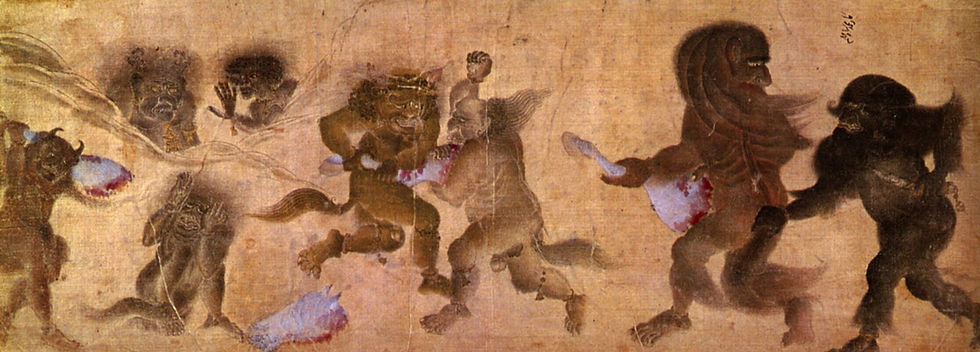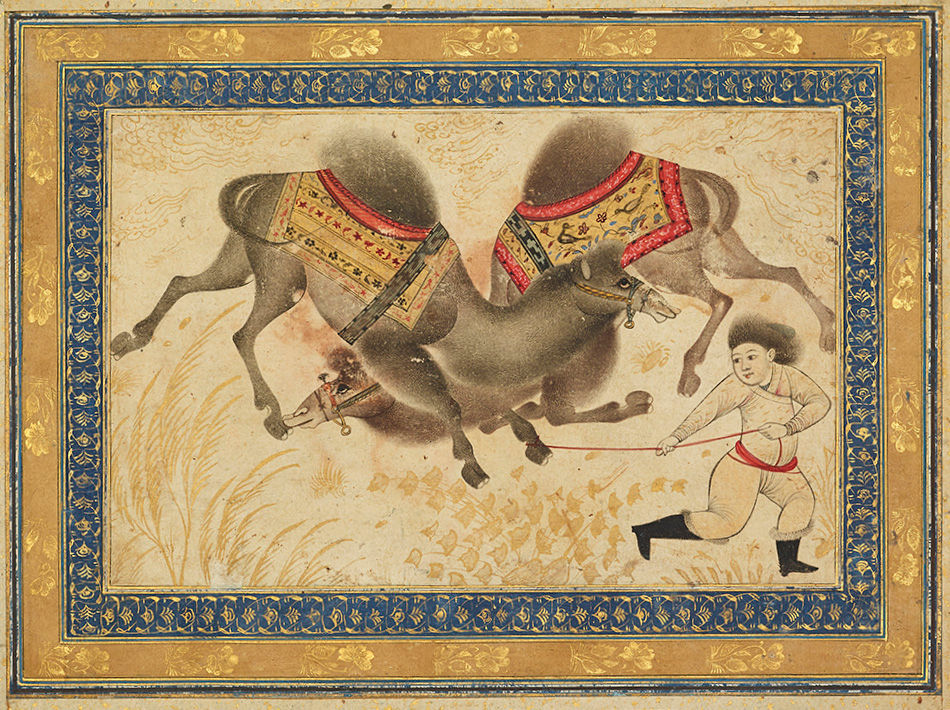[Art/History/Culture] Siyah Qalam: An Unknown Genius (14th Century)
- Sireen El Araj
- Nov 18, 2023
- 9 min read
An introduction to one of the most mysterious and controversial Muslim artists of all time. The nomadic Persian silk painter.

This article was researched and written by our Palestinian resident creative Sireen El Araj, who previously sourced and meticulously translated an incredible 40-page Egyptian dictionary of ancient illustrated mythological creatures from Arabic to English. You can read her first article HERE

Mehmed Siyah Qalam (Persian: سیاه قَلَم, Turkish: Siyah Kalem) is a Persian painter and illustrator who is shrouded in secrecy. Born in Central Asia (Iran or Turkestan) in the fifteenth century, the life of this painter is still a mystery to many historians since it is not supported by any written text.

The only proof of his existence is his signature on a large number of pictures that were painted on separate papers or on pieces of silk between the 14th century and 15th century. The use of silk as a support for painting was rare in the region, suggesting these enigmatic paintings were produced elsewhere. This ambiguity, as well as the strange style and themes of his depictions, have sparked widespread controversy among art historians and archaeologists.

Siyah Qalem means "Black Pen" - he was certainly named this for his "dark" paintings in their central themes, imagery of shamans, demons and jinns, as well as in tones (black, red and brown). His series of paintings are now preserved in the Imperial Ottoman Palace Library (Topkapi Sarayi) And there are about 153 very exceptional miniatures attributed to him - or his school – and considered to be one of the most controversial drawings in the field. His paintings are found in the “Conqueror’s Albums,” so named because two portraits of Sultan Mehmed II "the Conqueror" are present in one of them. The albums are composed of miniatures taken from manuscripts from the 14th, 15th, and early 16th centuries, and a series of paintings are attributed to the mysterious Master Mehmed Siyah Qalem. Incredible mystical artwork.

He was expressing in his art two types of images, the first of which are pictures of a religious nature and the other relates to the daily life of the nomadic Bedouins, the steppe of western Central Asia who controlled the east-west trade route. Their common stylistic elements, color range, clothing, faces, ornamentation and details of the figures give these pictures an affinity to be depicted during the reign of Timurid and Turkmen rulers. They don’t resemble anything similar to the Tabriz painting style of Iran.

These images showcased some aspects of Totemism and primitive beliefs that were common in East Turkistan and some of the folk tales and legends known to the Turks in their vast deserts that revolved around the evil forces that possess capabilities that exceed what humans have and have frightening and terrifying forms. We also see a variety of personalities, Turks, Indians, Mongols, slaves, shamans, dervishes, Buddhists, Nestorian monks, rich, poor, giants, demons. The paintings of Siyah Qalem (Black Pen) present very valuable documentary information about various aspects of the everyday life of nomads from various ethnic and religious origins along the Silk Road.

It is possible to see the whole map of the Silk Road in the mobility of the art subject, artisanship, artist and artwork in Siyah Qalem’s work. His paintings depict nomads and nomadic life who wandered across many rich nations. The Turkic nomads of Central Asia possessed a pictorial tradition relating to religious beliefs, and those pictures accompanying storytelling and the recital of religious texts by heart were part of a long-standing tradition since the sixth century. In Asian cultures dominated by Buddhism or Manichaeism, pictorial representation played a very important role in religious life. Hence storytelling of this kind became firmly established as a tradition in Central Asia before the coming of Islam.

Secondly, the artisanship is mobile: the technique used in these paintings is mainly executed by brush and ink and has its origins in the Far East and Western China. The Mongols brought scroll painting to the Near East. Therefore, the Siyah Qalem's illustrate the influence of Silk Road and extension the possible transfer of symbols, iconography, meaning and artistic impact from China in the first half of the fifteenth century.

The plant used in the paper’s manufacturing also has its origins in northern and western China and the Himalayas. Moreover, the paper production method was traditionally used in Thailand, Nepal and Tibet. Thirdly, the artist himself is mobile and we can assume that he probably was a nomad. Siyah Qalem was a storyteller, he knew features, beliefs and customs of the steppe people and wandered from city to city, showing these pictures and telling related stories. The reason why the pictures are made in scroll form is because the most convenient way to carry documents in nomadic societies is to roll them up.

Unfortunately, due to the pre-Islamic pagan myths features of Siyah Qalem's artwork and the difficulty to keep the pictures in its scroll forms, these pictures were found incomplete after they were randomly cut, to be primitively affixed to paper coming from Iran, and it is noted that "they were executed on various materials such as coarse (Chinese paper) and coated paper (of the type commonly used in the Islamic era) along with Silk, as it is also noted that some of them are nothing but small parts drawn on it, which indicates that they are parts cut from large rolls", which made it difficult to identify their original sizes and sizes. These pictures were arranged randomly by an unknown official in the pages of albums in the Treasury Library at Topkapi Palace Museum.

And finally, the artwork itself is mobile since the paintings were probably made somewhere in Central Asia, Khurasan and Iran around the 15th century, then placed in the albums of the Aqqoyunlu ruler Yakub Beg whose court was in Tabriz. Finally they ended up in the Ottoman court, Istanbul, as a wartime booty in the early 16th century. All these elements allow us to characterise his art as "the art of the Silk Road".

The paintings themselves have started a debate among scholars that is still going on till this day to determine the origins and the nature of such unorthodox images. Their compositions are highly expressive and full of movement and strength. The drawings have been described as evidencing the "brutal realism of the draftsmanship [while] the lyricism of the refined delineations is of such intensity that it has been matched only in isolated instances in Buddhist as well as Islamic paintings".

The demons in Siyah Qalem's paintings are instantly identifiable, as a body of work they are quite diverse. The stylistic details and the forms of them are more varied than the ones we find in the representation of human beings who have repetitive positions and limited facial and psychical expressions compared to the demons. There is no consensus as to what a demon is supposed to look like, so that may have given the artist the freedom to picture them with a variety of innovative forms and positions.

The structure of these creatures is very similar to the human anatomy but their skins are distinguished by black at times and red and yellow at other times, they have frightening heads that are topped with horns, wrinkled faces, wide mouths, long fangs, short necks and intense eyes that are wide and narrow with a clearly defined iris and pupil. Siyah Qalam has linked these ugly faces with short and thick bodies with razor sharp claws. These strange creatures wear clothes that cover up half of their lower body and are sometimes adorned with metal rings that they place in their arms, wrists, and necks.

These brutal and scary creatures with their rough and jagged features that resemble the texture of masks appear to act like people, where they wear their clothes and move in actions similar to the movements of us humans. Their actions positions are varied and interesting, they are not always involved in devilish activities, several scenes showcased pairs of quietly seated demons holding cups and pots or dancing or playing music.

Such scenes often appeared in Siyah Qalem’s work, together with the symbol of the cup, due to the fact that dance and music were the principal elements of theatre that played an important part in the lives of nomads communities. They were committed to music, and saw music and dance as significant ways of coming close to God, to recalling him back into our lives. When in ecstasy, the Qalandars danced to the sound of diverse instruments: drums, horns, stringed instruments and bells with the percussion of two chips. They equally played the qobuz, the stringed instrument accompanying the recitation of Turkish epics.

Modern ethnological research indicates that the nomadic communities of western Central Asia did not completely abandon the pre-Islamic pagan faiths and ceremonies of Shamanist times after their conversion to Islam. People look on dervishes as shamans of an earlier era, and believe that the dervish shaykhs have inherited the supernatural powers with which their ancestors invested the shamans. In the painting of “Dancing Shamans”, two dark skinned dervishes are dancing with excitement. The revolving motion of dervishes is depicted by waving scarves. Siyah Qalem gives emotion to hands, feet and faces and the distortion of the limbs – one foot is shown from above, the other from below, and the elbow and wrist of one arm are twisted backwards – underscoring the fluid turning motion of their bodies.


The paintings are full of movement and strength and an anti-graceful taste completely absent in Persian calligraphic art. Some of his figures are not depicted from a specific angle according to the perspective rules. The distortion of figures makes it seem like they're in motion. This expressive style presents emotions such as astonishment, fear, curiosity and joy. Siyah Qalem is very different from the traditional Islamic figurative artist, where faces are inexpressive and figures are still. These paintings show a pessimistic forcefulness and realism wholly lacking in Persian art of the 15th century. It is possible that they provided a major influence on Turkish painting, which departed from the idyllic, languid, and romantic path taken by Persian art.

Siyah Qalem received strong influence from Chinese and Mongols. Under Mongol supremacy the Islamic world was influenced by the cultures of the Far East and Central Asia in which figurative painting enjoyed a privileged status, The fact that this imagery full of excessive expressions of misery, and weight of movement and as it is also fraught with the influences of Chinese moguls that seems clear in drawing the folds of the elderly clothes.


By examining the transmission of images, styles, iconography, forms, and by extension the transfer of symbols, meaning and artistic impact from Chinese sources to Siyah Qalem paintings, we can discover some common motifs existing in Buddhist mural art in the regions of northern China.

Monsters, demons, supernatural beings: In the Siyah Qalem paintings, an important feature of the demons is that they have tails. These tails are reminiscent of creatures like snakes or dragons. They bite their “owners” or sometimes, when two demons are fighting, bite the other demon. Another notable feature of the demons is that they have horns. We can see two different kinds of horn: one similar to that of a ram, the other to that of a deer. In some paintings, we see that these demons possessing different kinds of horns are fighting each other. Also important to note is that they have chains or rings on their feet, arms, necks and ears. These features are very common in Buddhist mural art, check the comparison below.
The depiction of the Guardian of the East shares some similarities with Siyah Kalem demons. He paints some parts of the body (like the belt and shoulders) as snakes or dragons; moving, biting independent of the “owner”. He also paints chains or rings on different parts of the body. The symbolic meaning of these motifs must further be questioned. It must surely surpass the resemblance of artistic form and style and contain an interaction in the cultural and symbolic meaning level.

Scholars think that there is a possibility of Siyah Qalem being a painting school in Transoxania or Khurasan in the fifteenth century that was consisted of many artists. The similar content pictures seem not to be the work of a single hand. For instance, the Siyah Qalem paintings in Topkapi Palace were not produced by the same artist. The art of Siyah Qalem have been assigned several dates and places of origins by scholar, ranging in source from Istanbul to the borders of Russia and China, and in the time of the 14th, 15th, and 16th centuries.

Whether Siyah Qalem existed as a person or not what we can at least be sure about is his work has a special philosophical vision, that has nothing to do with natural (realistic) art. His art arose in seeing a world that is based on the existence of spiritual beings, separate from bodies, where everything is natural and has a soul, and is under the control of hidden powers, while the world of Siyah Qalem is governed by mysterious powers and magic, it is his world. A perfect reflection of an era that was ruled by myths and legends and his art pledged to serve as a means of communication between people and spirits. We can agree that he wasn't just an artist but also a shaman. The shadow of Siyah Qalem lives on.

~ PSYCHIC GARDEN
Sources
Hammond, B. (2016). The Secret History of the Mongols. In B. Hammond, Voices from the Twelfth-Century Steppe.
Karavit, K. P. (n.d.). Tell me a story of the Silk Road: Mehmed Siyah Kalem Paintings. Retrieved from Turkis culture Foundation.
vv Bloom, Jonathan, Blair, Sheila (eds). Grove Encyclopedia of Islamic Art & Architecture. Oxford: Oxford University Press, 2009.
Robinson, B.W. Persian Book of Kings: An Epitome of the Shahnama of Firdaws. Routledge, 2012.
Walther, Ingo. Codices Illustres. Berlin: Taschen Verlag, 2001.
A COMPARATIVE STUDY ON THE QALANDAR DERVISHES IN SIYAH QALEM’S PAINTINGS WITH OTHER PAINTERS’ PICTURES AND WRITTEN TEXTS: Tolga ERKAN
SIYAH QALAM: NEW PERSPECTIVES. Lynda Gillard. University of Edinburgh







![[Art/History/Culture] Kitab al-Bulhan - "The Book of Wonders" (14th Century)](https://static.wixstatic.com/media/78e459_1c4842a9507a4621a5f9f907cfbeb6f4~mv2.jpg/v1/fill/w_623,h_500,al_c,q_80,enc_avif,quality_auto/78e459_1c4842a9507a4621a5f9f907cfbeb6f4~mv2.jpg)
![[Art/Culture] Egyptian Dictionary of Illustrated Mythological Creatures](https://static.wixstatic.com/media/78e459_2f08e78f72be45b691fc9c4049d535fb~mv2.png/v1/fill/w_980,h_742,al_c,q_90,usm_0.66_1.00_0.01,enc_avif,quality_auto/78e459_2f08e78f72be45b691fc9c4049d535fb~mv2.png)
![[Art] Alfredo Conrique (HeyPogo)](https://static.wixstatic.com/media/78e459_a66924bcb87a4b37bcc207824caf8a59~mv2.jpg/v1/fill/w_980,h_607,al_c,q_85,usm_0.66_1.00_0.01,enc_avif,quality_auto/78e459_a66924bcb87a4b37bcc207824caf8a59~mv2.jpg)